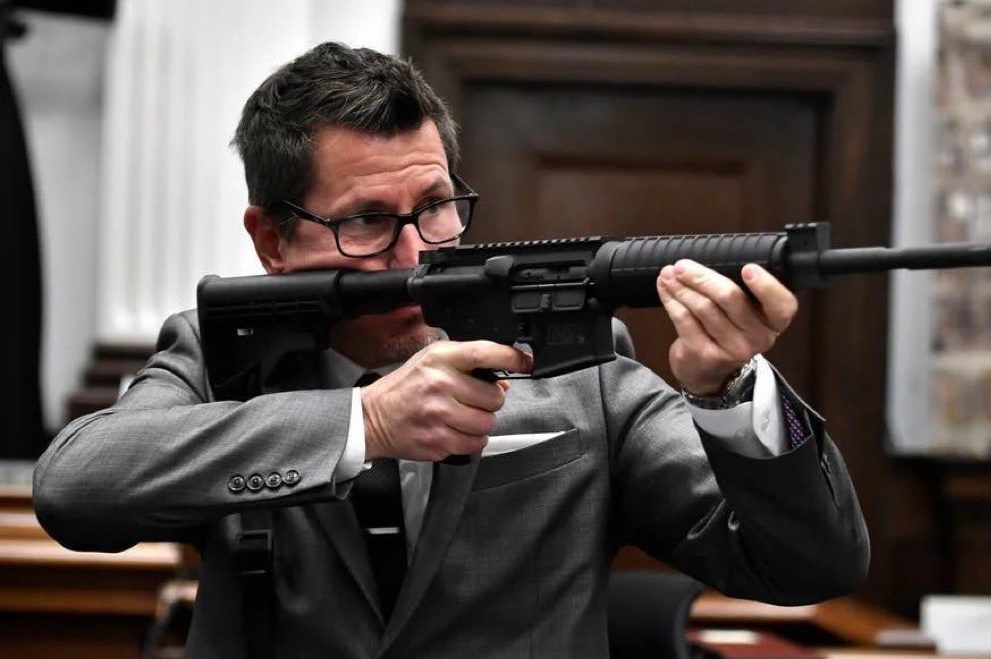There are three basic rules of gun safety: always keep your firearm pointed in a safe direction, always keep it unloaded until you’re ready to use, and never put your finger on the trigger until you’re ready to shoot. Thomas Binger, the lead prosecutor in the Kyle Rittenhouse trial, violated two of those three rules in the courtroom Monday.
Binger, who has built most of his case on Rittenhouse’s decision to carry a rifle to the Kenosha riots last summer, pointed a rifle at the crowded courtroom with his finger directly on the trigger. It was a stunning bookend to the prosecution’s fantastical argument against Rittenhouse, and the latest reminder that those who wish to take away your right to defend yourself with firearms know next to nothing about them.
Binger held up the rifle as a demonstration; he alleged that Rittenhouse pointed his gun at another rioter prior to shooting Joseph Rosenbaum. According to Binger’s version of events, Rittenhouse “provoked” the violence against him, while the rioters who attacked him were “heroes” trying to stop an active shooter.
Binger’s claim that Rittenhouse pointed his gun at other rioters before Rosenbaum rests on grainy drone footage “enhanced” by a forensic imaging specialist. The specialist admitted that he did not compare the zoomed-in version of the video to the original. He also testified that new pixels will be added to enlarged images, thus undermining their accuracy. The footage was so dubious that the judge was reticent to even allow it into evidence. Most importantly, Binger did not call those he claims were at the end of Rittenhouse’s gun to testify.
Most of Binger’s earlier arguments were even more brazen, undermining the basic right to self defense.
“You lose the right to self-defense when you’re the one who brought the gun,” Binger said at one point Monday, suggesting that merely carrying a firearm constitutes a direct threat to others. This not only flies in the face of the Second Amendment, but by such logic, those in the courtroom would have been justified in rushing Binger when he pointed a rifle in their direction during his closing argument.
In questioning Rittenhouse during his testimony last week, Binger intentionally blurred the lines between being an aggressor and a victim. He argued that Rittenhouse had no reason to be afraid of Rosenbaum because he had a weapon and Rosenbaum did not. Rosenbaum, Binger claimed, was the one acting in self-defense because a gun was pointed at him. The video evidence, however, shows that Rittenhouse was retreating and Rosenbaum was chasing. If Rosenbaum was only trying to protect himself, he almost certainly would have stopped his advance when Rittenhouse raised his rifle. Instead, he lunged for Rittenhouse’s weapon.
Binger attempted the same argument on behalf of Anthony Huber, the man who assaulted Rittenhouse with a skateboard, and Gaige Grosskreutz, who pointed a handgun at Rittenhouse’s head. Rittenhouse was retreating and verbalized that he was going to the police when rioters struck him in the head, knocking him to the ground. It was then, when he could no longer run away, that Huber and Grosskreutz attacked him. Still, Binger claimed that Rittenhouse shouldn’t have feared for his life because he had a rifle against Huber’s skateboard and Grosskreutz’s handgun.
Yes, Binger actually argued in a court of law that you may not defend yourself if your attacker has a physically smaller weapon than you.
Binger’s standard for self-defense would lead to open season on gun owners. The logical conclusion of his argument is that any time someone carries a firearm, even legally, those around him are justified in assuming that he is an active shooter and reacting accordingly. The gun owner would then be forbidden from protecting himself because those who attacked him were acting in “self-defense.”
This was not the only absurd line of reasoning about firearms followed by Binger. He argued that Rittenhouse should not have been in fear of his weapon being taken by Rosenbaum because he was wearing a rifle sling, the purpose of which is to prevent disarmament. Rittenhouse testified that the sling’s purpose that night was to keep his hands free so he could render medical aid to the injured. Hunters regularly use slings to prevent fatigue when carrying heavy rifles long distances. Even so, could Rittenhouse have reasonably depended on a cheap rifle sling to save his life in the split second that Rosenbaum tried to snatch his weapon?
Judge Schroeder stepped in on Monday to dismiss one of the more obviously bunk gun charges the state brought against Rittenhouse, confirming that 17-year-olds are legally allowed to carry long guns in Wisconsin. This was a major blow to Binger’s case as it undermined the notion that Rittenhouse was acting recklessly or illegally before he was attacked.
The jury in the Rittenhouse trial will start deliberations on Tuesday. The stakes are high. The prosecution has made sure that this is not just about a teenage boy’s life, but about the basic right to self-defense and to bear arms. If the jury decides that the act of carrying a firearm nullifies your right to protect yourself, gun owners everywhere better look out.


















